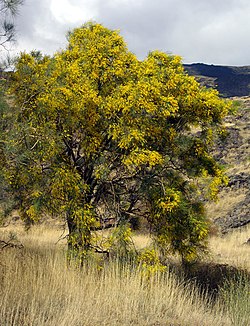| Genista aetnensis | |
|---|---|
 | |
| Scientific classification | |
| Kingdom: | Plantae |
| Clade: | Tracheophytes |
| Clade: | Angiosperms |
| Clade: | Eudicots |
| Clade: | Rosids |
| Order: | Fabales |
| Family: | Fabaceae |
| Subfamily: | Faboideae |
| Genus: | Genista |
| Species: | G. aetnensis |
| Binomial name | |
| Genista aetnensis | |
| Subspecies [2] | |
| |
| Synonyms [2] | |
| |
Genista aetnensis, the Mount Etna broom, [3] is a species of flowering plant in the legume family Fabaceae. It is a large shrub or small tree endemic to Corsica, Sardinia, and Sicily [2] where it is associated with sunny, open landscapes and poor, stony soil. It is a very common constituent of the garigue plant communities, Mediterranean shrubby vegetation, around the lower slopes of Mount Etna, hence its Latin specific epithet aetnensis. [4]
The young plant is typical of brooms, clothed in narrow linear leaves which soon drop off leaving almost bare branches. As it ages the shrub develops into a shapely small tree with a greenish bark, growing to 8 metres (26 ft) if given room to develop. The terminal branches have a tendency to droop and weep. Abundant pea-like, yellow, jasmine-scented flowers cover the whole crown in late summer. [5]
Two subspecies are accepted: [2]
- Genista etnensis subsp. etnensis – Sicily
- Genista etnensis subsp. sarda(C.Presl) Fridl. – Corsica and Sardinia
It is sometimes grown in gardens and landscaping, both for flower and for its attractive shape when mature. It is hardy down to −15 °C (5 °F). In cultivation in the UK it has gained the Royal Horticultural Society's Award of Garden Merit. [6] [7]

